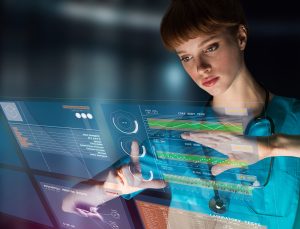Picture a hospital where nurses monitor a critical patient’s vital signs from a digital device in the palm of their hand. The real-time data is continually compared against their medical records in the backend, presenting vital insights regarding the patient’s condition within minutes or even seconds. Based on these insights, the nurses connect remotely with relevant physicians or specialists and deliver immediate, guided care whenever needed.
This vision of technology in nursing care is steadily turning into reality.
Even as we speak, the nursing profession is undergoing a remarkable transformation. It is shedding the outdated stereotypes of nurses as mere medication administrators and bedside caregivers. Nurses today are embracing patient care tech with open arms.
These tech-savvy healers are at the helm of the digital revolution transforming patient care as we know it. They are harnessing the power of the latest innovations in patient care tech to elevate their craft and streamline processes, paving the way for a healthcare experience that is more efficient, accurate, and more compassionate.
HOW IS TECHNOLOGY IN NURSING CARE ENHANCING HEALTHCARE PROCESSES?
Whether by leveraging virtual reality simulations for immersive training or artificial intelligence to augment clinical decision-making, nurses are exploring all the innovations in healthcare. Here are some ways in which nurses are using technology to take healthcare services to the next level:
Hands-On Training with Simulation Technology
Simulation technology enables nurses to get hands-on training in safe and controlled environments. For instance, high-fidelity patient simulators–advanced manikins designed to mimic human physiology and responses–can exhibit symptoms such as altered breathing patterns, changes in vital signs, and medication responses. High-risk situations like cardiac arrest or childbirth complications can also be simulated using this technology, making it easier to test the nurses’ decision-making and critical thinking skills.
Augmenting Clinical-Decision Making with AI
Nurses in many tech-evolved health centers are leveraging AI-powered clinical decision-support tools. AI algorithms can analyze vast amounts of patient data, including medical histories, lab results, and real-time monitoring data, allowing nurses to identify patterns within minutes. They can also identify and flag high-risk patients, facilitating preventative measures or treatment plans.
During emergencies, nurses can use AI to prioritize patients by quickly analyzing their vital signs, symptoms, and other relevant information. The efficient allocation of resources ensures that the most life-threatening cases are addressed promptly, leading to better patient outcomes. By providing data-driven insights and recommendations, AI can help nurses make more informed choices, ultimately leading to a higher standard of care.
Breaking Geographical Barriers with Telehealth
The role of nurses in the growing adoption of telehealth cannot be overstated, as it can be used to provide remote care and support to patients who face limited healthcare accessibility owing to geographical constraints.
From virtual consultations and remote monitoring, nurses can remotely assess symptoms, provide guidance, and offer personalized care. This is especially beneficial for patients with limited mobility, like those living in secluded areas or facing increased demand for healthcare services.
Simplifying Medication Management with Sensors
Patient monitoring technology in medication management by nurses is paving the way for improved patient safety, efficiency, and quality of care. By integrating electronic health records (EHRs), computerized physician order entry (CPOE) systems, and clinical decision support systems (CDSS), nurses are identifying potential drug interactions, allergies, and dosing errors, ultimately eliminating any medication mishaps.
Wearable technology is another sensor-powered domain that nurses are exploring. The unobtrusive devices worn by patients continuously track vital signs, medication adherence, and even physical activity levels. This real-time data stream gives nurses a comprehensive picture of a patient’s well-being, enabling them to identify potential issues before they escalate and intervene proactively.
STRIKING THE RIGHT ‘HUMAN-TECHNOLOGY’ BALANCE IN NURSING

Technology is undoubtedly transforming nursing, but the heart of the profession lies in the human touch it brings to the healthcare industry. Therefore, balancing expertise and humanity with technology is crucial for achieving the best possible patient outcomes.
Here are some strategies that nurses can employ to strike this balance:
Embracing Technology as an Enabler: Technology should enhance nursing practice, not replace the human touch and personal interactions that are essential in healthcare. Nurses should seek ways to seamlessly incorporate technology into their routine processes, whether using EHRs to document patient information, leveraging telehealth to monitor patients remotely, or utilizing mobile apps for patient support. However, while using technology to interact with patients, they should strive to maintain eye contact, active listening, and genuine compassion, which is a crucial part of the care process.
Developing Digital Literacy and Competency: As patient care tech evolves in healthcare, nurses must stay up-to-date with the latest tools, systems, and applications relevant to their practice. Ongoing education and training can help them make judicious use of technology while prioritizing their critical thinking skills.
Advocating Patient-Centered Technology: Nurses, as frontline healthcare professionals, can play a crucial role in advocating for the development and implementation of technology that prioritizes patient welfare and experience. They can do so by providing feedback and insights to various stakeholders responsible for advancing technology in healthcare. This will ensure that patient safety and quality of care remain the top priorities.
By striking the right balance between their expertise, humanity, and technological proficiency, nurses can deliver more compassionate and evidence-based care, ultimately improving patient outcomes.
TECH-SAVVY NURSES ARE THE FUTURE OF HEALTHCARE
As nurses balance technological advancement and humanized care, the healthcare landscape is poised for a new transformation–one in which patients benefit most.
Even for healthcare professionals, integrating technology in nursing care is opening doors for new specializations and career paths. Nurse informaticists, for instance, will play a crucial role in bridging the gap between healthcare and information technology. Their expertise will be invaluable in today’s tech-driven healthcare landscape, enabling nurses to leverage technology effectively and efficiently.
As we look to the future, there are boundless possibilities that novel technologies hold for nurses worldwide. It is only the unwavering dedication and adaptability that are needed to shape the trajectory of this technological revolution in nursing.
Nurses interested in sharing their professional experiences and insights can register with MDForLives. Our platform allows healthcare providers and patients to participate in paid medical surveys tailored to their expertise.
They can also share case studies, articles, and blogs at collaboration@mdforlives.com and earn exclusive rewards!
A. Royden D’Souza is a professional writer with over 5 years of experience in the healthcare industry. He holds an engineering degree and has worked with several brands to meet their content requirements. He is passionate about writing engaging content for healthcare professionals, allied healthcare professionals, and nurses.






